UV Fused Silica Broadband Plate Beamsplitters (Coating: 600 - 1700 nm)
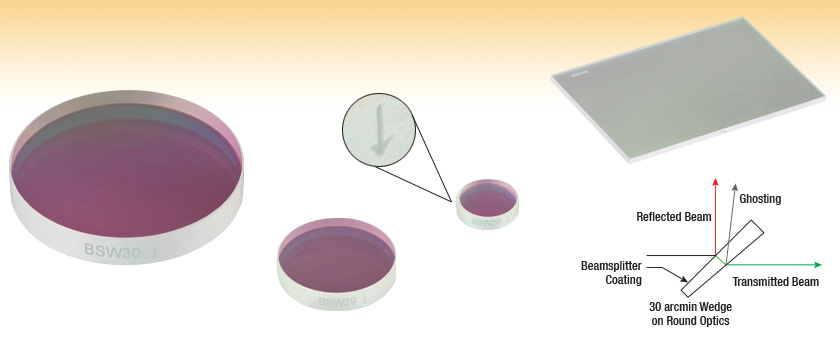
- Beamsplitter Coating for the 600 - 1700 nm Range
- Optimized for 50:50 Beam Splitting at 45° Incidence
- Ø1/2", Ø1", 25 mm x 36 mm, and Ø2" Sizes
BSW30
Ø2"
BSW29
Ø1"
BSW28
Ø1/2"
BSW29R
25 mm x 36 mm
Engraved Arrow
Points in the Direction
of Light Transmission

Please Wait
| Table 1.1 Plate Beamsplitter Selection Guide | |
|---|---|
| Substrate | Beamsplitter Coating |
| UV Fused Silica | 250 - 450 nm |
| 350 - 1100 nm | |
| 400 - 700 nm | |
| 532 nm and 1064 nm | |
| 600 - 1700 nm | |
| 700 - 1100 nm | |
| 1.2 - 1.6 µm | |
| IR Fused Silica | 0.9 - 2.6 µm |
| Calcium Fluoride | 1 - 6 μm |
| 2 - 8 μm | |
| Zinc Selenide | 1 - 12 μm |
| 7 - 14 μm | |
Features
- Beamsplitter Coating on Front Surface: 600 - 1700 nm
- Optimized for 50:50 Beamsplitting for a 45° Angle of Incidence (AOI)
- Antireflection (AR) Coating on Back Surface: 600 - 1700 nm
- Ø1/2", Ø1", 25 mm x 36 mm, and Ø2" Versions Available
- UV Fused Silica Substrate (Transmission Curve)
- 30 arcmin Wedged Back Surface on Round Beamsplitters Minimizes Ghosting
Thorlabs' 50:50 UV Fused Silica Broadband Beamsplitters, which are available in Ø1/2" , Ø1", 25 mm x 36 mm, and Ø2" versions, have a beamsplitter coating for the 600 - 1700 nm range deposited on the front surface that has been optimized for a 45° AOI. A dielectric coating provides long-term stability.
These plate beamsplitters are fabricated from UV-grade fused silica, which offers high transmission deep into the UV, good homogeneity, and a lower coefficient of thermal expansion than N-BK7. In addition, UV fused silica exhibits virtually no laser-induced fluorescence (as measured at 193 nm), making it an ideal choice for applications from UV to near IR.
To help reduce unwanted interference effects (e.g., ghost images) caused by the interaction of light reflected from the front and back surfaces of the optic, all of these plate beamsplitters have an antireflection (AR) coating deposited onto the back surface. This coating is designed for the same operating wavelength range as the beamsplitter coating on the front surface. Approximately 4% of the light incident at 45° on an uncoated substrate will be reflected; by applying an AR coating to the back side of the beamsplitter, this percentage is reduced to an average of less than 1.5% over the entire operating range of the coating. In addition to this feature, the back of all of our round broadband plate beamsplitters has a 30 arcmin wedge; therefore, the fraction of light that does get reflected from this AR-coated surface will diverge.
The edge of each round plate beamsplitter is engraved with the item number and an arrow pointing to the AR-coated, wedged surface (see the Specs Tab for an illustration). Our rectangular beamsplitters, which have been designed for mounting in microscopy filter cubes, feature the engraved item number on the side with the beamsplitter coating, making it easy to differentiate between the front and back surfaces.
Thorlabs offers three types of non-polarizing beamsplitters: Non-polarizing Beamsplitting Cubes (mounted and unmounted), Pellicle Beamsplitters (mounted and unmounted), and the Plate Beamsplitters (see below and Table 1.1). For a direct comparison of the performance of our non-polarizing beamsplitting cube, plate, and pellicle at 633 nm, see the Lab Facts tab.
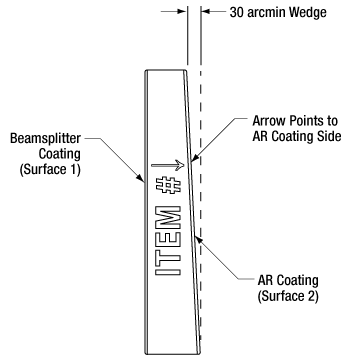
Note: Round Beamsplitter Not Drawn to Scale
| Item # | BSW28 | BSW29 | BSW29Ra | BSW30 |
|---|---|---|---|---|
| Size | Ø1/2" (Ø12.7 mm) |
Ø1" (Ø25.4 mm) |
25.0 mm x 36.0 mm | Ø2" (Ø50.8 mm) |
| Thickness | 3 mm | 5 mm | 1.0 mm | 8 mm |
| Split Ratio (T:R) | 50:50 | |||
| Dimensional Tolerance | +0.0 mm / -0.2 mm | ±0.1 mm | +0.0 mm / -0.2 mm | |
| Center Thickness Tolerance | ±0.4 mm | ±0.1 mm | ±0.4 mm | |
| Substrate | UV Fused Silicab | |||
| Clear Aperture | >Ø11.43 mm | >Ø22.86 mm | >22.5 mm x 32.4 mm | >Ø45.72 mm |
| Surface Flatness | λ/4 at 633 nm Over the Clear Aperture | - | λ/4 at 633 nm Over the Clear Aperture | |
| Transmitted Wavefront Error | - | λ/2 at 633 nm Over the Clear Aperture | - | |
| Coating on Surface 1 | 600 - 1700 nm Beamsplitter Coating for 45° AOI | |||
| Coating on Surface 2 | Broadband AR Coating for 600 - 1700 nm (Ravg <1.5% within Wavelength Range at 45° AOI) |
|||
| Overall Performance | Tabs = 50 ± 10%, Rabs = 50 ± 10%, Tabs + Rabs > 99%, |Ts-Tp| < 40% and |Rs-Rp| < 40%, 45° AOI |
|||
| Surface Quality | 20-10 Scratch-Dig | 40-20 Scratch-Dig | 20-10 Scratch-Dig | |
| Durability | MIL-M-13508C, MIL-C-675C, MIL-C-14806 | |||
| Damage Threshold (CWc) |
1000 W/cm (1070 nm, Ø0.091 mm) | |||
| Damage Threshold (Pulsed) |
6 J/cm2 (1064 nm, 10 ns, 10 Hz, Ø0.515 mm) | |||
Thorlabs Lab Fact: Beamsplitter Package Matters
We present laboratory measurements of the polarization angle, split ratio, and total throughput power of a beam transmitted through Thorlabs plate, cube, and pellicle beamsplitters. While all non-polarizing beamsplitters function similarly, the exact performance is different for different types of beamsplitter. Each type of beamsplitter contains its own advantages and disadvantages compared to other types of beamsplitters. Appropriate choice of beamsplitter is essential to sensitive experimental systems. We present a complete analysis and comparison of optical parameters for three common types of non-polarizing beamsplitters.
For our experiment we used the former generation HRS015 stabilized HeNe laser (replaced by the HRS015B) as the light source for our investigation. A linear polarizer is used to set the laser beam's polarization axis to 45° in order to provide equal s- and p-polarized light incident on the beamsplitter. The beamsplitter under investigation was then placed in the beampath, and its split beams directed to appropriate detectors. The total power though the optic, polarization states, split ratios, and angle of incidence effects were investigated under this configuration.
Figures 167A through 167C summarize the measured results for all three types of beamsplitters. From these graphs the performance of each optic can be easily compared to one another. Figure 167A summarizes the results for the total power throughput for each optic. The total power throughput is measured as the fraction of input power. While the plate and pellicle beamsplitters perform rather similarly, the cube shows signs of absorption inside the optic. Additionally, this plot shows the relative insensitivity of throughput power to angle of incidence. Figure 167B summarizes the results for the output polarization angle for each optic. The cube shows the most similar polarization angles between the reflected and transmitted beams, with the plate producing the largest difference in polarization between beams. Figure 167C plot summarizes the results for the split ratio, as a fraction of input power, for the beamsplitters. Here it can be shown that the plate beamsplitter demonstrates the most ideal for 50/50 power splitting. For details on the experimental setup employed and the results summarized here, please click here.
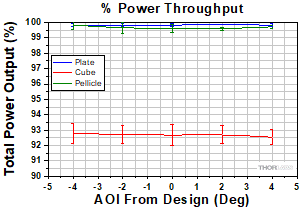
Click to Enlarge
Figure 167A Beamsplitter Throughput
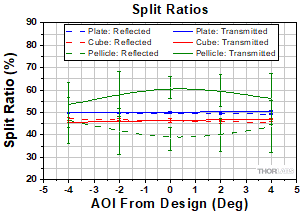
Click to Enlarge
Figure 167C Beamsplitter Split Ratios
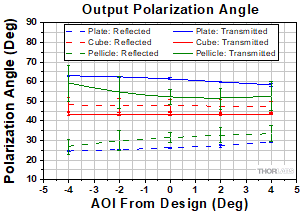
Click to Enlarge
Figure 167B Beamsplitter Output Polarization Angles
| Table 4.1 Damage Threshold Specifications | ||
|---|---|---|
| Coating Designation (Item # Prefix) |
Damage Threshold | |
| BSW2- | CWa | 1000 W/cm (1070 nm, Ø0.091 mm) |
| Pulsed | 6 J/cm2 (1064 nm, 10 ns, 10 Hz, Ø0.515 mm) | |
Damage Threshold Data for Thorlabs' UV Fused Silica Plate Beamsplitters
The specifications in Table 4.1 are measured data for Thorlabs' UV fused silica plate beamsplitters. Damage threshold specifications are constant for all 600 - 1700 nm, UV fused silica beamsplitters, regardless of the size of the beamsplitter.
Laser Induced Damage Threshold Tutorial
The following is a general overview of how laser induced damage thresholds are measured and how the values may be utilized in determining the appropriateness of an optic for a given application. When choosing optics, it is important to understand the Laser Induced Damage Threshold (LIDT) of the optics being used. The LIDT for an optic greatly depends on the type of laser you are using. Continuous wave (CW) lasers typically cause damage from thermal effects (absorption either in the coating or in the substrate). Pulsed lasers, on the other hand, often strip electrons from the lattice structure of an optic before causing thermal damage. Note that the guideline presented here assumes room temperature operation and optics in new condition (i.e., within scratch-dig spec, surface free of contamination, etc.). Because dust or other particles on the surface of an optic can cause damage at lower thresholds, we recommend keeping surfaces clean and free of debris. For more information on cleaning optics, please see our Optics Cleaning tutorial.
Testing Method
Thorlabs' LIDT testing is done in compliance with ISO/DIS 11254 and ISO 21254 specifications.
First, a low-power/energy beam is directed to the optic under test. The optic is exposed in 10 locations to this laser beam for 30 seconds (CW) or for a number of pulses (pulse repetition frequency specified). After exposure, the optic is examined by a microscope (~100X magnification) for any visible damage. The number of locations that are damaged at a particular power/energy level is recorded. Next, the power/energy is either increased or decreased and the optic is exposed at 10 new locations. This process is repeated until damage is observed. The damage threshold is then assigned to be the highest power/energy that the optic can withstand without causing damage. A histogram such as that shown in Figure 37B represents the testing of one BB1-E02 mirror.

Figure 37A This photograph shows a protected aluminum-coated mirror after LIDT testing. In this particular test, it handled 0.43 J/cm2 (1064 nm, 10 ns pulse, 10 Hz, Ø1.000 mm) before damage.

Figure 37B Example Exposure Histogram used to Determine the LIDT of
| Table 37C Example Test Data | |||
|---|---|---|---|
| Fluence | # of Tested Locations | Locations with Damage | Locations Without Damage |
| 1.50 J/cm2 | 10 | 0 | 10 |
| 1.75 J/cm2 | 10 | 0 | 10 |
| 2.00 J/cm2 | 10 | 0 | 10 |
| 2.25 J/cm2 | 10 | 1 | 9 |
| 3.00 J/cm2 | 10 | 1 | 9 |
| 5.00 J/cm2 | 10 | 9 | 1 |
According to the test, the damage threshold of the mirror was 2.00 J/cm2 (532 nm, 10 ns pulse, 10 Hz, Ø0.803 mm). Please keep in mind that these tests are performed on clean optics, as dirt and contamination can significantly lower the damage threshold of a component. While the test results are only representative of one coating run, Thorlabs specifies damage threshold values that account for coating variances.
Continuous Wave and Long-Pulse Lasers
When an optic is damaged by a continuous wave (CW) laser, it is usually due to the melting of the surface as a result of absorbing the laser's energy or damage to the optical coating (antireflection) [1]. Pulsed lasers with pulse lengths longer than 1 µs can be treated as CW lasers for LIDT discussions.
When pulse lengths are between 1 ns and 1 µs, laser-induced damage can occur either because of absorption or a dielectric breakdown (therefore, a user must check both CW and pulsed LIDT). Absorption is either due to an intrinsic property of the optic or due to surface irregularities; thus LIDT values are only valid for optics meeting or exceeding the surface quality specifications given by a manufacturer. While many optics can handle high power CW lasers, cemented (e.g., achromatic doublets) or highly absorptive (e.g., ND filters) optics tend to have lower CW damage thresholds. These lower thresholds are due to absorption or scattering in the cement or metal coating.

Figure 37D LIDT in linear power density vs. pulse length and spot size. For long pulses to CW, linear power density becomes a constant with spot size. This graph was obtained from [1].

Figure 37E Intensity Distribution of Uniform and Gaussian Beam Profiles
Pulsed lasers with high pulse repetition frequencies (PRF) may behave similarly to CW beams. Unfortunately, this is highly dependent on factors such as absorption and thermal diffusivity, so there is no reliable method for determining when a high PRF laser will damage an optic due to thermal effects. For beams with a high PRF both the average and peak powers must be compared to the equivalent CW power. Additionally, for highly transparent materials, there is little to no drop in the LIDT with increasing PRF.
In order to use the specified CW damage threshold of an optic, it is necessary to know the following:
- Wavelength of your laser
- Beam diameter of your beam (1/e2)
- Approximate intensity profile of your beam (e.g., Gaussian)
- Linear power density of your beam (total power divided by 1/e2 beam diameter)
Thorlabs expresses LIDT for CW lasers as a linear power density measured in W/cm. In this regime, the LIDT given as a linear power density can be applied to any beam diameter; one does not need to compute an adjusted LIDT to adjust for changes in spot size, as demonstrated in Figure 37D. Average linear power density can be calculated using this equation.

This calculation assumes a uniform beam intensity profile. You must now consider hotspots in the beam or other non-uniform intensity profiles and roughly calculate a maximum power density. For reference, a Gaussian beam typically has a maximum power density that is twice that of the uniform beam (see Figure 37E).
Now compare the maximum power density to that which is specified as the LIDT for the optic. If the optic was tested at a wavelength other than your operating wavelength, the damage threshold must be scaled appropriately. A good rule of thumb is that the damage threshold has a linear relationship with wavelength such that as you move to shorter wavelengths, the damage threshold decreases (i.e., a LIDT of 10 W/cm at 1310 nm scales to 5 W/cm at 655 nm):

While this rule of thumb provides a general trend, it is not a quantitative analysis of LIDT vs wavelength. In CW applications, for instance, damage scales more strongly with absorption in the coating and substrate, which does not necessarily scale well with wavelength. While the above procedure provides a good rule of thumb for LIDT values, please contact Tech Support if your wavelength is different from the specified LIDT wavelength. If your power density is less than the adjusted LIDT of the optic, then the optic should work for your application.
Please note that we have a buffer built in between the specified damage thresholds online and the tests which we have done, which accommodates variation between batches. Upon request, we can provide individual test information and a testing certificate. The damage analysis will be carried out on a similar optic (customer's optic will not be damaged). Testing may result in additional costs or lead times. Contact Tech Support for more information.
Pulsed Lasers
As previously stated, pulsed lasers typically induce a different type of damage to the optic than CW lasers. Pulsed lasers often do not heat the optic enough to damage it; instead, pulsed lasers produce strong electric fields capable of inducing dielectric breakdown in the material. Unfortunately, it can be very difficult to compare the LIDT specification of an optic to your laser. There are multiple regimes in which a pulsed laser can damage an optic and this is based on the laser's pulse length. The highlighted columns in Table 37F outline the relevant pulse lengths for our specified LIDT values.
Pulses shorter than 10-9 s cannot be compared to our specified LIDT values with much reliability. In this ultra-short-pulse regime various mechanics, such as multiphoton-avalanche ionization, take over as the predominate damage mechanism [2]. In contrast, pulses between 10-7 s and 10-4 s may cause damage to an optic either because of dielectric breakdown or thermal effects. This means that both CW and pulsed damage thresholds must be compared to the laser beam to determine whether the optic is suitable for your application.
| Table 37F Laser Induced Damage Regimes | ||||
|---|---|---|---|---|
| Pulse Duration | t < 10-9 s | 10-9 < t < 10-7 s | 10-7 < t < 10-4 s | t > 10-4 s |
| Damage Mechanism | Avalanche Ionization | Dielectric Breakdown | Dielectric Breakdown or Thermal | Thermal |
| Relevant Damage Specification | No Comparison (See Above) | Pulsed | Pulsed and CW | CW |
When comparing an LIDT specified for a pulsed laser to your laser, it is essential to know the following:

Figure 37G LIDT in energy density vs. pulse length and spot size. For short pulses, energy density becomes a constant with spot size. This graph was obtained from [1].
- Wavelength of your laser
- Energy density of your beam (total energy divided by 1/e2 area)
- Pulse length of your laser
- Pulse repetition frequency (prf) of your laser
- Beam diameter of your laser (1/e2 )
- Approximate intensity profile of your beam (e.g., Gaussian)
The energy density of your beam should be calculated in terms of J/cm2. Figure 37G shows why expressing the LIDT as an energy density provides the best metric for short pulse sources. In this regime, the LIDT given as an energy density can be applied to any beam diameter; one does not need to compute an adjusted LIDT to adjust for changes in spot size. This calculation assumes a uniform beam intensity profile. You must now adjust this energy density to account for hotspots or other nonuniform intensity profiles and roughly calculate a maximum energy density. For reference a Gaussian beam typically has a maximum energy density that is twice that of the 1/e2 beam.
Now compare the maximum energy density to that which is specified as the LIDT for the optic. If the optic was tested at a wavelength other than your operating wavelength, the damage threshold must be scaled appropriately [3]. A good rule of thumb is that the damage threshold has an inverse square root relationship with wavelength such that as you move to shorter wavelengths, the damage threshold decreases (i.e., a LIDT of 1 J/cm2 at 1064 nm scales to 0.7 J/cm2 at 532 nm):

You now have a wavelength-adjusted energy density, which you will use in the following step.
Beam diameter is also important to know when comparing damage thresholds. While the LIDT, when expressed in units of J/cm², scales independently of spot size; large beam sizes are more likely to illuminate a larger number of defects which can lead to greater variances in the LIDT [4]. For data presented here, a <1 mm beam size was used to measure the LIDT. For beams sizes greater than 5 mm, the LIDT (J/cm2) will not scale independently of beam diameter due to the larger size beam exposing more defects.
The pulse length must now be compensated for. The longer the pulse duration, the more energy the optic can handle. For pulse widths between 1 - 100 ns, an approximation is as follows:

Use this formula to calculate the Adjusted LIDT for an optic based on your pulse length. If your maximum energy density is less than this adjusted LIDT maximum energy density, then the optic should be suitable for your application. Keep in mind that this calculation is only used for pulses between 10-9 s and 10-7 s. For pulses between 10-7 s and 10-4 s, the CW LIDT must also be checked before deeming the optic appropriate for your application.
Please note that we have a buffer built in between the specified damage thresholds online and the tests which we have done, which accommodates variation between batches. Upon request, we can provide individual test information and a testing certificate. Contact Tech Support for more information.
[1] R. M. Wood, Optics and Laser Tech. 29, 517 (1998).
[2] Roger M. Wood, Laser-Induced Damage of Optical Materials (Institute of Physics Publishing, Philadelphia, PA, 2003).
[3] C. W. Carr et al., Phys. Rev. Lett. 91, 127402 (2003).
[4] N. Bloembergen, Appl. Opt. 12, 661 (1973).
In order to illustrate the process of determining whether a given laser system will damage an optic, a number of example calculations of laser induced damage threshold are given below. For assistance with performing similar calculations, we provide a spreadsheet calculator that can be downloaded by clicking the LIDT Calculator button. To use the calculator, enter the specified LIDT value of the optic under consideration and the relevant parameters of your laser system in the green boxes. The spreadsheet will then calculate a linear power density for CW and pulsed systems, as well as an energy density value for pulsed systems. These values are used to calculate adjusted, scaled LIDT values for the optics based on accepted scaling laws. This calculator assumes a Gaussian beam profile, so a correction factor must be introduced for other beam shapes (uniform, etc.). The LIDT scaling laws are determined from empirical relationships; their accuracy is not guaranteed. Remember that absorption by optics or coatings can significantly reduce LIDT in some spectral regions. These LIDT values are not valid for ultrashort pulses less than one nanosecond in duration.

Figure 71A A Gaussian beam profile has about twice the maximum intensity of a uniform beam profile.
CW Laser Example
Suppose that a CW laser system at 1319 nm produces a 0.5 W Gaussian beam that has a 1/e2 diameter of 10 mm. A naive calculation of the average linear power density of this beam would yield a value of 0.5 W/cm, given by the total power divided by the beam diameter:

However, the maximum power density of a Gaussian beam is about twice the maximum power density of a uniform beam, as shown in Figure 71A. Therefore, a more accurate determination of the maximum linear power density of the system is 1 W/cm.
An AC127-030-C achromatic doublet lens has a specified CW LIDT of 350 W/cm, as tested at 1550 nm. CW damage threshold values typically scale directly with the wavelength of the laser source, so this yields an adjusted LIDT value:

The adjusted LIDT value of 350 W/cm x (1319 nm / 1550 nm) = 298 W/cm is significantly higher than the calculated maximum linear power density of the laser system, so it would be safe to use this doublet lens for this application.
Pulsed Nanosecond Laser Example: Scaling for Different Pulse Durations
Suppose that a pulsed Nd:YAG laser system is frequency tripled to produce a 10 Hz output, consisting of 2 ns output pulses at 355 nm, each with 1 J of energy, in a Gaussian beam with a 1.9 cm beam diameter (1/e2). The average energy density of each pulse is found by dividing the pulse energy by the beam area:

As described above, the maximum energy density of a Gaussian beam is about twice the average energy density. So, the maximum energy density of this beam is ~0.7 J/cm2.
The energy density of the beam can be compared to the LIDT values of 1 J/cm2 and 3.5 J/cm2 for a BB1-E01 broadband dielectric mirror and an NB1-K08 Nd:YAG laser line mirror, respectively. Both of these LIDT values, while measured at 355 nm, were determined with a 10 ns pulsed laser at 10 Hz. Therefore, an adjustment must be applied for the shorter pulse duration of the system under consideration. As described on the previous tab, LIDT values in the nanosecond pulse regime scale with the square root of the laser pulse duration:

This adjustment factor results in LIDT values of 0.45 J/cm2 for the BB1-E01 broadband mirror and 1.6 J/cm2 for the Nd:YAG laser line mirror, which are to be compared with the 0.7 J/cm2 maximum energy density of the beam. While the broadband mirror would likely be damaged by the laser, the more specialized laser line mirror is appropriate for use with this system.
Pulsed Nanosecond Laser Example: Scaling for Different Wavelengths
Suppose that a pulsed laser system emits 10 ns pulses at 2.5 Hz, each with 100 mJ of energy at 1064 nm in a 16 mm diameter beam (1/e2) that must be attenuated with a neutral density filter. For a Gaussian output, these specifications result in a maximum energy density of 0.1 J/cm2. The damage threshold of an NDUV10A Ø25 mm, OD 1.0, reflective neutral density filter is 0.05 J/cm2 for 10 ns pulses at 355 nm, while the damage threshold of the similar NE10A absorptive filter is 10 J/cm2 for 10 ns pulses at 532 nm. As described on the previous tab, the LIDT value of an optic scales with the square root of the wavelength in the nanosecond pulse regime:

This scaling gives adjusted LIDT values of 0.08 J/cm2 for the reflective filter and 14 J/cm2 for the absorptive filter. In this case, the absorptive filter is the best choice in order to avoid optical damage.
Pulsed Microsecond Laser Example
Consider a laser system that produces 1 µs pulses, each containing 150 µJ of energy at a repetition rate of 50 kHz, resulting in a relatively high duty cycle of 5%. This system falls somewhere between the regimes of CW and pulsed laser induced damage, and could potentially damage an optic by mechanisms associated with either regime. As a result, both CW and pulsed LIDT values must be compared to the properties of the laser system to ensure safe operation.
If this relatively long-pulse laser emits a Gaussian 12.7 mm diameter beam (1/e2) at 980 nm, then the resulting output has a linear power density of 5.9 W/cm and an energy density of 1.2 x 10-4 J/cm2 per pulse. This can be compared to the LIDT values for a WPQ10E-980 polymer zero-order quarter-wave plate, which are 5 W/cm for CW radiation at 810 nm and 5 J/cm2 for a 10 ns pulse at 810 nm. As before, the CW LIDT of the optic scales linearly with the laser wavelength, resulting in an adjusted CW value of 6 W/cm at 980 nm. On the other hand, the pulsed LIDT scales with the square root of the laser wavelength and the square root of the pulse duration, resulting in an adjusted value of 55 J/cm2 for a 1 µs pulse at 980 nm. The pulsed LIDT of the optic is significantly greater than the energy density of the laser pulse, so individual pulses will not damage the wave plate. However, the large average linear power density of the laser system may cause thermal damage to the optic, much like a high-power CW beam.
| Posted Comments: | |
由祐 村上
(posted 2023-04-24 10:08:00.273) BSW29で45°入射から透過した光のシフト量を教えてください。
またBSW29の屈折率を教えてください。 jdelia
(posted 2023-05-02 02:28:54.0) Thank you for contacting Thorlabs. Regarding your first question on how much the optical axis shifts when it is incident on BSW29 with an AOI of 45 degrees, that can be calculated from Snell's law. We have reached out to you directly to discuss this in further detail. Your next question was about the refractive index of BSW29. Since BSW29 is UVFS, the refractive index is approximately 1.46. However, it depends on wavelength, please see the following web page if you need more accurate value: https://www.thorlabs.com/newgrouppage9.cfm?objectgroup_id=6973&tabname=UV%20Fused%20Silica Runmin Li
(posted 2022-08-22 16:46:45.52) Can a beamsplitter with 30 arcmin Wedged Back Surface be used as beam combiner? ppestre
(posted 2022-09-19 03:10:01.0) Response from Tech Support Japan:
Thank you for contacting Thorlabs.
A beamsplitter can be used to make two different beams interfere. Please keep in mind that the light intensity will be 50% each.
I hope this helps. If you have questions please let us know. 辉明 罗
(posted 2021-09-09 09:48:29.247) 这款是否有10:90,反射端90. YLohia
(posted 2021-09-09 03:38:10.0) Hello, an applications engineer from our team in China (techsupport-cn@thorlabs.com) will discuss this directly with you. yoonsmith
(posted 2017-06-26 14:30:42.41) What is the birefregence of material used on BSW29 (Beam splitter) in 1550 nm region ? Does it generate optical path length variation about 100 nm in BSW29 induced by polarization state? tfrisch
(posted 2017-07-20 11:51:58.0) Hello, thank you for contacting Thorlabs. I would expect no significant birefringence as both the substrate and coating layers are amorphous. I will reach out to you directly to discuss the limited data we have on this. neil.troy
(posted 2014-08-09 08:46:42.2) Looking at the data it appears that, for example, the transmission & reflectance for S polarized light is >50% across the range. Is this an error in labeling? That would mean there is more than 100% of the light accounted for. Likewise, in the P polarized the sum of percentages is always significantly less than 100%. myanakas
(posted 2014-08-11 09:12:55.0) Response from Mike at Thorlabs: Thank you for your feedback. You are correct, there was an error in the transmission plot that was being displayed on the web. The P- and S-polarization states were mislabeled in the legend. Based on your feedback this error has been fixed on the web. tangjianwei1024
(posted 2013-02-02 07:59:46.987) I would like to use this 600-1700nm broadband 50/50 beamsplitter on my Nikon inverted microscope to achieve NIR reflective illumination, therefore 25mm*36mm*1mm sized beamsplitter is needed (to be mounted in the filter cube). The 25mm*36mm sized beamsplitter is available for 400-700nm (BSW10R) and 700-1100nm (BSW11R). However, I didn't find my wanted size for 600-1700nm beamsplitter. How can I purchase? Thanks! tcohen
(posted 2013-02-06 16:16:00.0) Response from Tim at Thorlabs: Thank you very much for your feedback! We will be adding this to our product line and I will contact you to keep you updated. user
(posted 2012-11-15 20:53:31.457) Thanks.
GONG tcohen
(posted 2012-11-15 11:52:21.183) Response from Tim at Thorlabs: We do not have damage threshold data for the BSW29 on hand. This will be tested soon and I will contact you to keep you updated. xj.gong
(posted 2012-11-15 04:47:58.3) Could you tell me the damage threshold of the BSW29? I cannot find the data on your website,Thanks.
GONG |
Beamsplitter Selection Guide
Thorlabs' portfolio contains many different kinds of beamsplitters, which can split beams by intensity or by polarization. We offer plate and cube beamsplitters, though other form factors exist, including pellicle and birefringent crystal. For an overview of the different types and a comparison of their features and applications, please see our overview. Many of our beamsplitters come in premounted or unmounted variants. In this tab is a complete listing of our beamsplitter offerings. To explore the available types, wavelength ranges, splitting/extinction ratios, transmission, and available sizes for each beamsplitter category, click More [+] in the appropriate row.Plate Beamsplitters
| Non-Polarizing Plate Beamsplitters |
|---|
| Polarizing Plate Beamsplitters |
|---|
Cube Beamsplitters
| Non-Polarizing Cube Beamsplitters |
|---|
| Polarizing Cube and Polyhedron Beamsplitters |
|---|
Pellicle Beamsplitters
| Non-Polarizing Pellicle Beamsplitters |
|---|
Crystal Beamsplitters
| Polarizing Crystal Beamsplitters |
|---|
Other
| Other Beamsplitters |
|---|

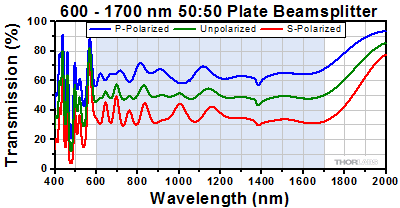
Click to Enlarge
Click for Raw Data in the 300 - 2600 nm Range
Figure G1.1 Transmission data for the broadband plate beamsplitters coated for 600 - 1100 nm was obtained for a 45° AOI. The shaded region denotes the stated beamsplitter coating range. Transmission was measured using a Perkin Elmer Lambda 950 UV/VIS/NIR spectrophotometer with a calcite polarizer attachment.
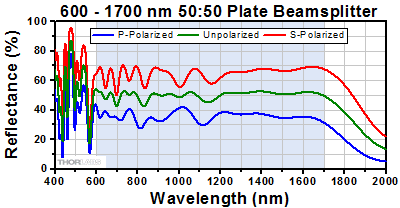
Click to Enlarge
Click for Raw Data in the 300 - 2600 nm Range
Figure G1.2 Reflectance data for the broadband plate beamsplitters coated for 600 - 1100 nm was obtained for a 45° AOI. The shaded region denotes the stated beamsplitter coating range. Reflectance was measured using a Perkin Elmer Lambda 950 UV/VIS/NIR spectrophotometer with a calcite polarizer attachment.
 Products Home
Products Home












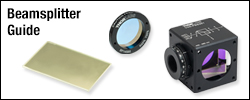
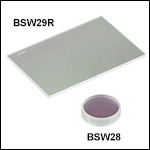
 Zoom
Zoom UV Fused Silica Plate Beamsplitters (Visible - IR)
UV Fused Silica Plate Beamsplitters (Visible - IR)